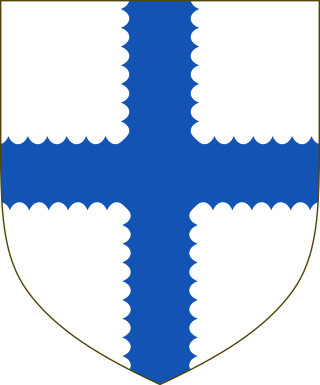
Lord Sinclair is a title in the Peerage of Scotland. According to James Balfour Paul's The Scots Peerage, volume VII published in 1910, the first person to be styled Lord Sinclair was William Sinclair, 3rd Earl of Orkney and 1st Earl of Caithness. However, according to Roland Saint-Clair writing in the late 19th century, William Sinclair's father, Henry II Sinclair, Earl of Orkney, who died in 1420, is the first person recorded as Lord Sinclair by public records.

Clan Sinclair is a Highland Scottish clan which holds the lands of Caithness, the Orkney Islands, and the Lothians. The chiefs of the clan were the Barons of Roslin and later the Earls of Orkney and Earls of Caithness.

Cousland is a village in Midlothian, Scotland. It is located 4 kilometres (2.5 mi) east of Dalkeith and 3 kilometres (1.9 mi) west of Ormiston, on a hill between the Rivers Tyne and Esk.

Morham, East Lothian, sometimes spelt Moram, Morum, or Morhame in old records, is the smallest (agricultural) parish in Scotland, sandwiched between five other parishes: Haddington, Garvald, Yester, Whittingehame, and Prestonkirk, in the undulating lower reaches of the Lammermuir Hills.
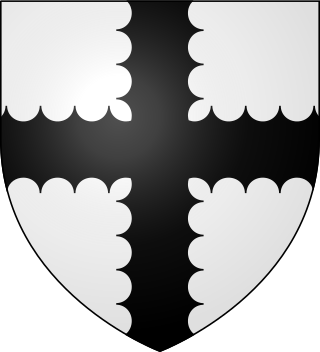
Baron of Roslin or Rosslyn was a Scottish feudal barony held by the St Clair or Sinclair family.

Oliver Castle was a medieval tower house, located in upper Tweedsdale in the Scottish Borders. The site of the hillfort known as Oliver Castle is to the north of the village of Tweedsmuir, although the site of the tower house is less certain. Mentioned in a document of c.1200, it was originally part of the line of peel towers along the Tweed Valley. It was replaced in the seventeenth century by a house, which was itself replaced in the late 18th century by the present Oliver House. For most of its existence the property has been owned by members of the Tweedie family.
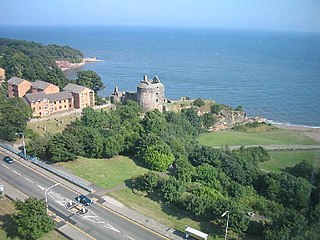
Ravenscraig Castle is a ruined castle located in Kirkcaldy which dates from around 1460. The castle is an early example of artillery defence in Scotland.
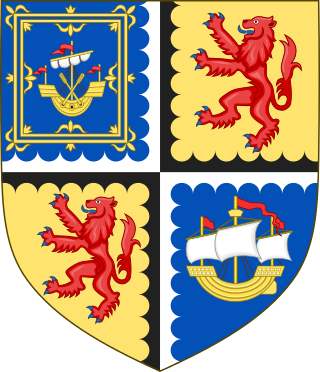
William Sinclair was a Scottish nobleman, the 2nd Earl of Caithness and chief of the Clan Sinclair, a Scottish clan of the Scottish Highlands.
Carfrae Bastle is a small ruined tower house about 5 miles (8.0 km) north of Lauder, Scottish Borders, Scotland, near Hillhouse

William St. Clair, 6th Baron of Roslin, was a Scottish nobleman of the late 13th century.

William Sinclair of Newburgh, Aberdeenshire was a Scottish nobleman and the 3rd Lord Sinclair. In The Scots Peerage by James Balfour Paul he is designated as the 2nd Lord Sinclair, but historian Roland Saint-Clair designates him the 3rd Lord Sinclair in reference to his descent from his grandfather, Henry II Sinclair, Earl of Orkney, the first Lord Sinclair. Roland Saint-Clair references this to an Act of the Scottish Parliament in which William Sinclair's son, Henry Sinclair, 4th Lord Sinclair, was made Lord Sinclair based on his descent from his great-grandfather, Henry II Sinclair, Earl of Orkney, the first Lord Sinclair. Bernard Burke, in his a Genealogical and Heraldic Dictionary of the Peerage and Baronetage of the British Empire, agrees with Roland Saint-Clair and says that Henry Sinclair was "in reality" the fourth holder of the title of Lord Sinclair.

Oliver St Clair was a Scottish noble and the 12th Baron of Roslin.

Henry Sinclair was a Scottish noble and the 4th Lord Sinclair. In The Scots Peerage by James Balfour Paul he is designated as the 3rd Lord Sinclair, but historian Roland Saint-Clair designates him the 4th Lord Sinclair and references this to an Act of the Scottish Parliament in which he was made Lord Sinclair based on his descent from his great-grandfather, Henry II Sinclair, Earl of Orkney, the first Lord Sinclair. Bernard Burke, in his a Genealogical and Heraldic Dictionary of the Peerage and Baronetage of the British Empire, agrees with Roland Saint-Clair and says that Henry Sinclair was "in reality" the fourth holder of the title of Lord Sinclair.

William Sinclair was a Scottish nobleman and the 5th Lord Sinclair. In The Scots Peerage by James Balfour Paul he is designated as the 4th Lord Sinclair in descent starting from William Sinclair, 1st Earl of Caithness and 3rd Earl of Orkney, but historian Roland Saint-Clair designates him as the 5th Lord Sinclair in descent from the father of the 1st Earl of Caithness and 3rd Earl of Orkney, Henry II Sinclair, Earl of Orkney, who is the first person recorded as Lord Sinclair in public records. Roland Saint-Clair references this to an Act of the Scottish Parliament in which the 4th Lord Sinclair was made Lord Sinclair based on his descent from his great-grandfather, Henry II Sinclair, Earl of Orkney, the first Lord Sinclair. Bernard Burke, in his a Genealogical and Heraldic Dictionary of the Peerage and Baronetage of the British Empire, agrees with Roland Saint-Clair and says that William Sinclair was "in reality" the fifth Lord Sinclair.
Henry St Clair, Lord Herdmanston and Carfrae, was a Scottish noble of the 12th century.

William St Clair was a Scottish nobleman and the 15th Baron of Roslin.

John St Clair was a Scottish nobleman and the 17th Baron of Roslin.

Lord Herdmanston was a title in the Peerage of Scotland that was held by the Sinclair or St Clair family.
William St Clair, Lord Herdmanston, Baron of Carfrae and Cessford, was a Scottish noble of the 13th-14th centuries.
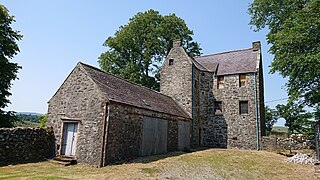
Earlstoun Castle, sometimes spelled Earlston Castle, is a derelict tower house near St John's Town of Dalry in Dumfries and Galloway, Scotland. Built in the late sixteenth century, it was home to members of the Gordon family, including William Gordon of Earlston who was killed at the battle of Bothwell Bridge. It is unusual for a tower house of its age for its lack of defensive arrangements: it has no gun loops, its roof is without a parapet or corner turrets, and it lies in open ground without natural defences.









